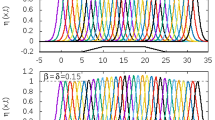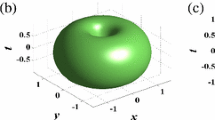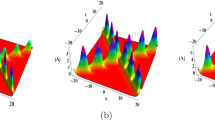Abstract
A mathematical model of a solitary wave of limiting amplitude propagating in a constant-depth channel is developed. The model is based on a conformal mapping of the domain of variation of a complex potential onto a domain approximating the domain of Stokes soliton flow. The results of the model are compared with the known numerical results. Using the model, the streamlines in both movable and fixed coordinate systems, as well as the isotachs, isoclinals, and isobars of the Stokes soliton, are constructed.
Similar content being viewed by others
References
J. McCowan, “On the highest wave of permanent type,”Phil. Mag., Ser. 5,38, No. 233, 351 (1894).
J. V. Wehausen and E. V. Laitone, “Surface waves,” in:Handbuch der Physik, Band 9, Springer (1960), p. 446.
C. W. Lenau, “The solitary wave of maximum amplitude,”J. Fluid Mech.,26, 309 (1966).
C. J. Amick and J. F. Toland, “On solitary water waves of finite amplitude,”Arch. Rat. Mech. Analys.,76, 9 (1981).
J. Witting, “On the highest and other solitary waves,”SIAM J. Appl. Math.,28, 700 (1975).
J. M. Williams, “Limiting gravity waves in water of finite depth,”Phil. Trans. Roy. Soc. London, Ser. A,302, No. 1466, 139 (1981).
J. K. Hunter and J. M. Vanden Broeck, “Accurate computations for steep solitary waves,”J. Fluid Mech.,136, 63 (1983).
W. A. B. Evans and M. J. Ford, “An exact integral equation for solitary waves (with new numerical results for some “internal” properties,”Proc. Roy. Soc. London, Ser. A,452, No. 1945, 373 (1996).
N. M. Sherykhalina, “Development of numerical algorithms for solving hydrodynamical problems with singular points on a free surface and experimental investigation of their convergence rates,” Paper No. 2550 -B95, Deposited at VINITI (1995).
V. I. Smirnov,Handbook of Higher Mathematics, Vol. 3, Part 2 [in Russian], Gostekhizdat, Moscow (1953).
V. P. Zhitnikov, N. M. Sherykhalina, and A. R. Urakov, “Using the method of separation of singularities for solving problems of heavy-fluid hydrodynamics and electrochemical forming,” in:Dynamics of Continua with Free Boundaries [in Russian], Chuvash Univ. Press, Cheboksary (1996), p. 97.
H. Lamb,Hydrodynamics, Cambridge Univ. Press, Cambridge (1924).
L. V. Ovsyannikov, “On the asymptotic representation of solitary waves,”Dokl. Akad. Nauk SSSR,318, 556 (1991).
N. N. Lebedev,Special Functions and Their Applications [in Russian], Gostekhizdat, Moscow (1953).
Additional information
Moscow. Translated from Izvestiya Rossiiskoi Akademii Nauk, Mekhanika Zhidkosti i Gaza, No. 1, pp. 174–180, January–February, 1999.
Rights and permissions
About this article
Cite this article
Ivanov, V.I. A mathematical model of the stokes soliton. Fluid Dyn 34, 147–152 (1999). https://doi.org/10.1007/BF02698766
Received:
Issue Date:
DOI: https://doi.org/10.1007/BF02698766




